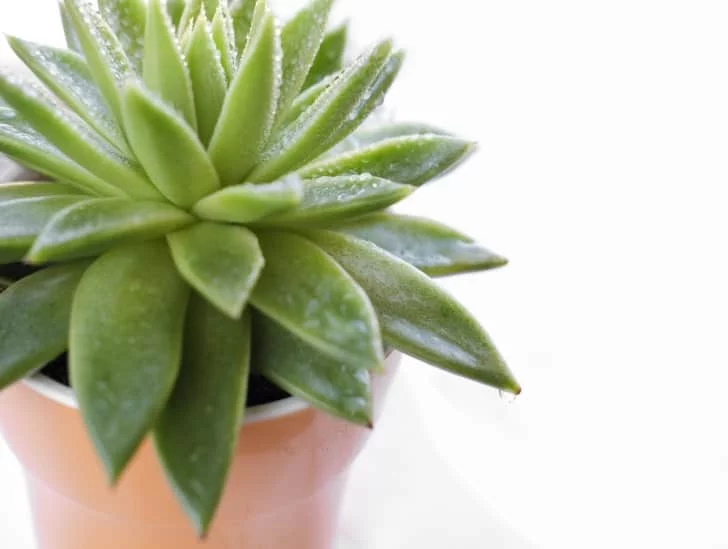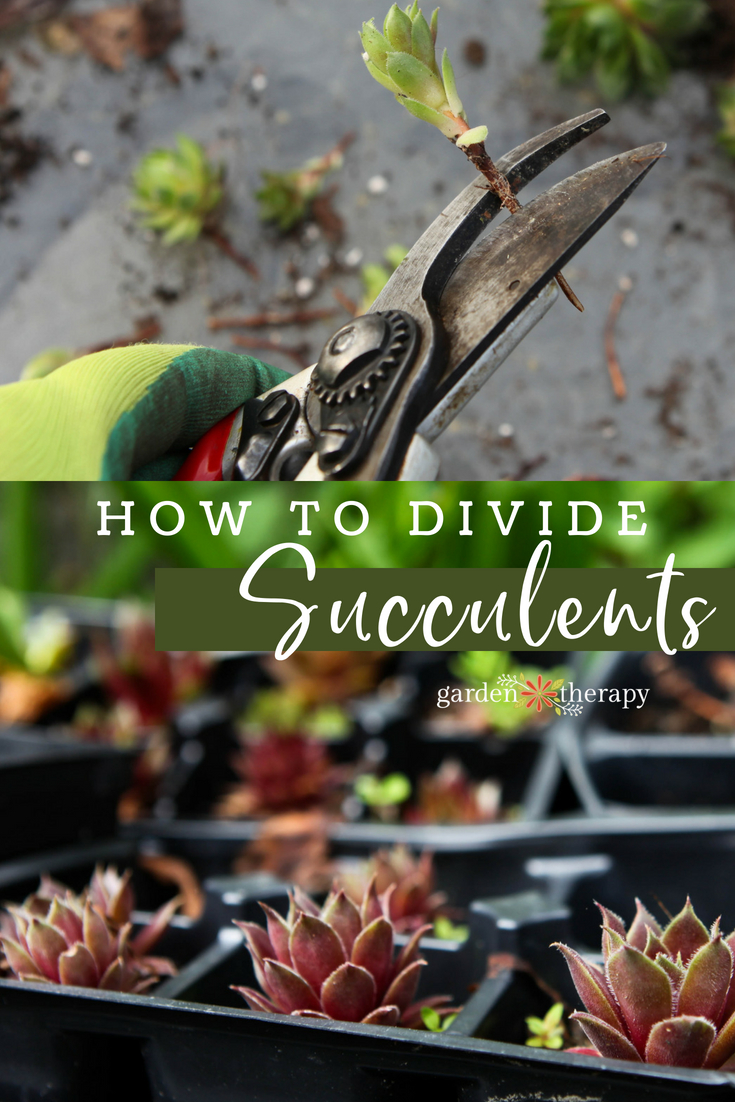How To Cut, Split And Propagate Sempervivum

Sempervivum, also known as houseleeks or Hen and Chickens, are a type of succulent that is easy to care for and propagate. They are native to Europe and North Africa and can tolerate harsh conditions, making them ideal for growing in rockeries or on walls. Sempervivum can be propagated by division or by seed, and will often self-seed in the garden.
Propagating and Planting SEMPERVIVUM – How to seperate newly purchased Hens and Chicks
- Start with a healthy mother plant that has been well-watered and fertilized
- Use a sharp knife to cut off a 2-3″ piece of the plant, making sure to include at least one leaf node
- Place the cutting in a glass of water and wait for it to develop roots, which could take up to two weeks
- Once the roots are established, carefully transplant the cutting into a pot filled with well-draining soil mix
- Water regularly and wait for the plant to establish itself before fertilizing again
How to Propagate Sempervivum Arachnoideum
Sempervivum arachnoideum, also known as Cobweb Houseleek, is a succulent plant in the Sempervivum genus that is native to the Pyrenees mountains. It is a rosette-forming succulent with thin, fleshy leaves that are covered in white cobweb-like hairs. The leaves grow up to 3 inches (7.6 cm) long and 2 inches (5 cm) wide.
The flowers are small and yellow, blooming in summer.
This plant is easy to propagate from offsets or leaf cuttings. To propagate from offsets, simply remove the offset from the mother plant and pot it up in well-draining soil.
Water sparingly until established. To propagate from leaf cuttings, cut a healthy leaf from the mother plant and allow it to callous over for a few days. Then, pot the leaf cutting up in well-draining soil and water sparingly until established.
How to Grow Sempervivum in Containers
Sempervivum, also known as houseleek or hen-and-chicks, is a succulent plant that is perfect for growing in containers. These plants are native to the mountains of Europe and can tolerate cold temperatures and dry conditions. Sempervivum are low-growing plants that form rosettes of fleshy leaves.
They produce small flowers in the summer, which are followed by seed pods.
To grow sempervivum in containers, choose a pot that is at least 8 inches wide and has drainage holes. Fill the pot with a well-draining cactus or succulent mix.
Water the potting mix until it is evenly moistened, then let it drain for an hour or so before planting your sempervivum. Place the plants in the pot so that their roots are covered with soil but their leaves are exposed. Once all of your plants are in place, water them lightly and wait for new growth to appear.
sempervivum need bright light to thrive, so place your pots in a sunny spot indoors or outdoors. Allow the soil to dry out between watering, but don’t let your plants experience prolonged drought conditions. In winter, reduce watering even further and keep your plants on the drier side to prevent root rot.
With proper care, your sempervivum should thrive for many years in their container home!
Unhealthy Hen And Chick Plant
If you have a hen and chick plant (Sempervivum tectorum) that’s looking unhealthy, there are a few things you can do to try to revive it. First, check the roots to see if they’re rotted or dried out. If they are, you can try replanting the hen and chicks in fresh potting soil.
If the roots seem healthy but the plant is still wilting, it may be getting too much sun. Try moving it to a shadier spot and see if that helps.
If your hen and chick plant is still struggling, one possible reason is that it’s not getting enough water.
Make sure you’re watering regularly (about once a week), and make sure the pot has drainage holes so the roots don’t get waterlogged. You may also want to fertilize your plant with a liquid fertilizer every month or so. With some TLC, your hen and chick plant should start to look healthier in no time!
Sempervivum from Seed
There’s something so satisfying about growing plants from seed. It’s a fun way to get more plants for your money, and it’s a great way to get exactly the varieties you want. Plus, it’s just really cool to see a plant that you grew yourself from a tiny little seedling!
If you’re thinking about growing Sempervivum from seed, there are a few things you should know. First of all, they’re not the easiest plants to grow from seed. They have very specific requirements in terms of temperature, humidity, and light levels.
But if you can provide the right conditions, they will germinate and grow into healthy plants.
Here are some tips for successfully growing Sempervivum from seed:
– Start with fresh seeds.
Seeds that are too old won’t germinate as well.
– Sow the seeds on the surface of well-draining soil or sand. Don’t cover them with anything because they need light to germinate.
Hens-And-Chicks Seeds
Hens-and-chicks seeds are a type offlowering plant that is native to Europe and Asia. The name “hens-and-chicks” comes from the plant’s habit of producing many small offsets or “chicks” around the main “hen” plant. These offsets can be used to propagate new plants, making hens-and-chicks an easy plant to grow.
The flowers of hens-and-chicks are small and white, with each blossom lasting only a day or two. However, the plants are very drought tolerant and will bloom continuously from spring through fall if given enough sun. Hens-and chicks are also resistant to most pests and diseases, making them a low maintenance option for gardeners.
If you’re looking for a cheerful addition to your garden that is easy to care for, consider growing hens-and chicks!

Credit: gardentherapy.ca
How Do You Take Cuttings from Sempervivum?
There are a few different ways that you can take cuttings from sempervivum, also known as houseleeks. The most common method is to simply take a leaf cutting from the plant. To do this, you will need to first remove a healthy leaf from the plant.
Make sure that the leaf has a good amount of stem attached to it. Next, use a sharp knife or garden shears to make a clean cut just below the base of the leaf. Once you have your cutting, you can either pot it up right away or place it in a glass of water until you’re ready to pot it.
Another way to take sempervivum cuttings is by division. This is best done in early spring when the plants are actively growing. Simply dig up the entire plant and gently pull it apart into smaller pieces, making sure that each piece has some roots attached.
You can then replant each piece in its own pot or container and water well.
No matter which method you choose, be sure to keep an eye on your cuttings and water them regularly until they have taken root and begun to grow new leaves. With a little patience and care, you’ll soon have plenty ofsempervivumto enjoy!
Can You Cut off Part of a Succulent And Replant It?
Yes, you can cut off part of a succulent and replant it. Just make sure to use a sharp knife or scissors and cut at a 45-degree angle. This will help the plant heal quickly and prevent rot.
Be sure to allow the cuttings to callous over (dry out) for a few days before replanting them.
Can I Propagate Sempervivum from Leaves?
Yes, you can propagate sempervivum from leaves. Place the leaf in a pot of moistened soil and keep it warm and humid. New plants will sprout from the leaf in a few weeks.
Can cutting and splitting sempervivum plants affect their blooming cycle?
Can cutting and splitting sempervivum plants affect their blooming cycle? sempervivum blooming tips suggest that cutting and splitting can actually stimulate their blooming cycle. By dividing the plants, you promote growth, allowing them to produce more offsets and flowers. However, it’s crucial to ensure proper care during this process to ensure successful blooming in the future.
When Should Sempervivum Be Separated?
Sempervivum, also known as houseleeks, are a type of succulent that are easy to care for and make a great addition to any indoor or outdoor space. They typically only need to be watered once a week and can tolerate some neglect. However, they will eventually outgrow their pot or container and will need to be divided.
The best time to divide sempervivum is in the spring or fall. This will give the plant time to recover from the stress of being divided and will help it thrive in its new environment.
Conclusion
Sempervivum, also known as houseleek or hens-and-chicks, are low-growing succulents that make excellent groundcover. They are easy to propagate from offsets, which are small plantlets that form around the base of the mother plant. In this post, we will show you how to cut and split sempervivum offsets and then pot them up so they can continue to grow.
To start, be sure to select healthy offsets that have roots attached. Using a sharp knife or gardening shears, cut the offset away from the mother plant at a 45-degree angle. Next, use your knife or shears to split the offset into two or three pieces, each with its own set of roots.
Once you have your pieces ready, it’s time to pot them up!
Fill a small pot with well-draining cactus mix or succulent soil and place your offsets in it. Gently press the soil around the roots and water lightly.
Be sure not to overwater as this can cause root rot. Sempervivum offsets need bright light but can tolerate some direct sun. Allow the soil to dry out completely between watering sessions.
With a little care, your offsets will soon take root and begin to grow!